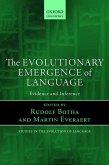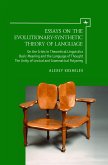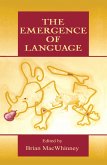Language has no counterpart in the animal world. Unique to Homo sapiens, it appears inseparable from human nature. But how, when and why did it emerge? The contributors to this volume - linguists, anthropologists, cognitive scientists, and others - adopt a modern Darwinian perspective which offers a bold synthesis of the human and natural sciences. As a feature of human social intelligence, language evolution is driven by biologically anomalous levels of social cooperation. Phonetic competence correspondingly reflects social pressures for vocal imitation, learning, and other forms of social transmission. Distinctively human social and cultural strategies gave rise to the complex syntactical structure of speech. This book, presenting language as a remarkable social adaptation, testifies to the growing influence of evolutionary thinking in contemporary linguistics. It will be welcomed by all those interested in human evolution, evolutionary psychology, linguistic anthropology, and general linguistics.
Table of contents:
Part I. The Evolution of Cooperative Communication: 1. Introduction: the evolution of cooperative communication Chris Knight; 2. Comprehension, production and conventionalization in the origins of language Robbins Burling; 3. Co-operation, competition and the evolution of pre-linguistic communication Jason Noble; 4. Language and hominid politics Jean-Louis Dessalles; 5. Secret language use at female initiation: bounding gossiping communities Camilla Power; 6. Play as precursor of phonology and syntax Chris Knight; Part II. The Emergence of Phonetic Structure: 7. Introduction: the emergence of phonetic structure Michael Studdert-Kennedy; 8. The role of mimesis in infant language development: evidence for phylogeny? Marilyn M. Vihman and Rory A. DePaolis; 9. Evolution of speech: the relation between ontogeny and phylogeny Peter J. MacNeilage and Barbara L. Davis; 10. Evolutionary implications of the particulate principle: imitation and the dissociation of phonetic form from semantic function Michael Studdert-Kennedy; 11. Emergence of sound systems through self-organisation Bart de Boer; 12. Modelling language-physiology coevolution Daniel Livingstone and Colin Fyfe; Part III. The Evolution of Syntax: 13. The emergence of syntax James R. Hurford; 14. The spandrels of the linguistic genotype David Lightfoot; 15. The distinction between sentences and noun phrases: an impediment to language evolution? Andrew Carstairs-McCarthy; 16. How protolanguage became language Derek Bickerton; 17. Holistic utterances in protolanguage: the link from primates to humans Alison Wray; 18. Syntax without natural selection: how compositionality emerges from vocabulary in a population of learners Simon Kirby; 19. Social transmission favours linguistic generalization James R. Hurford; 20. Words, memes and language evolution Robert P. Worden; 21. On the reconstruction of 'proto-world' word order Frederick J. Newmeyer; Epilogue; 22. The history, rate and pattern of world linguistic evolution Mark Pagel.
This book covers the origins and early evolution of language. Its main purpose is to synthesize current thinking on this topic, particularly from a standpoint in theoretical linguistics. It is suitable for students and scholars of human evolution, evolutionary psychology, linguistic anthropology, and general linguistics. It includes contributions from many of the best-known figures in this field.
This book covers the origins of language, combining social and natural science perspectives.
Table of contents:
Part I. The Evolution of Cooperative Communication: 1. Introduction: the evolution of cooperative communication Chris Knight; 2. Comprehension, production and conventionalization in the origins of language Robbins Burling; 3. Co-operation, competition and the evolution of pre-linguistic communication Jason Noble; 4. Language and hominid politics Jean-Louis Dessalles; 5. Secret language use at female initiation: bounding gossiping communities Camilla Power; 6. Play as precursor of phonology and syntax Chris Knight; Part II. The Emergence of Phonetic Structure: 7. Introduction: the emergence of phonetic structure Michael Studdert-Kennedy; 8. The role of mimesis in infant language development: evidence for phylogeny? Marilyn M. Vihman and Rory A. DePaolis; 9. Evolution of speech: the relation between ontogeny and phylogeny Peter J. MacNeilage and Barbara L. Davis; 10. Evolutionary implications of the particulate principle: imitation and the dissociation of phonetic form from semantic function Michael Studdert-Kennedy; 11. Emergence of sound systems through self-organisation Bart de Boer; 12. Modelling language-physiology coevolution Daniel Livingstone and Colin Fyfe; Part III. The Evolution of Syntax: 13. The emergence of syntax James R. Hurford; 14. The spandrels of the linguistic genotype David Lightfoot; 15. The distinction between sentences and noun phrases: an impediment to language evolution? Andrew Carstairs-McCarthy; 16. How protolanguage became language Derek Bickerton; 17. Holistic utterances in protolanguage: the link from primates to humans Alison Wray; 18. Syntax without natural selection: how compositionality emerges from vocabulary in a population of learners Simon Kirby; 19. Social transmission favours linguistic generalization James R. Hurford; 20. Words, memes and language evolution Robert P. Worden; 21. On the reconstruction of 'proto-world' word order Frederick J. Newmeyer; Epilogue; 22. The history, rate and pattern of world linguistic evolution Mark Pagel.
This book covers the origins and early evolution of language. Its main purpose is to synthesize current thinking on this topic, particularly from a standpoint in theoretical linguistics. It is suitable for students and scholars of human evolution, evolutionary psychology, linguistic anthropology, and general linguistics. It includes contributions from many of the best-known figures in this field.
This book covers the origins of language, combining social and natural science perspectives.








